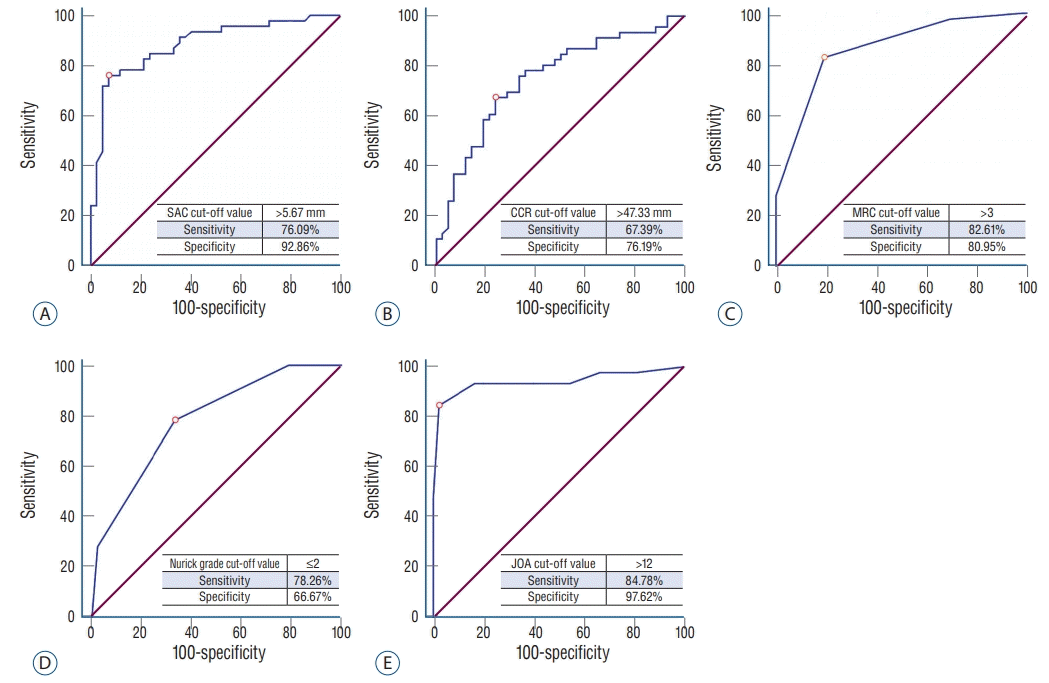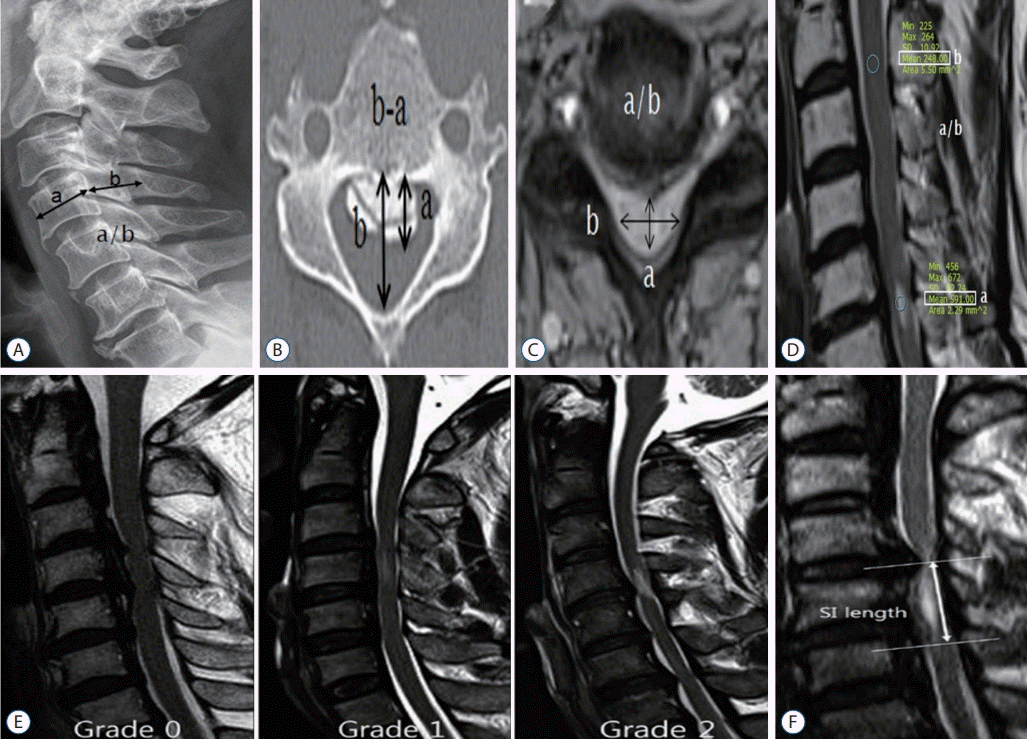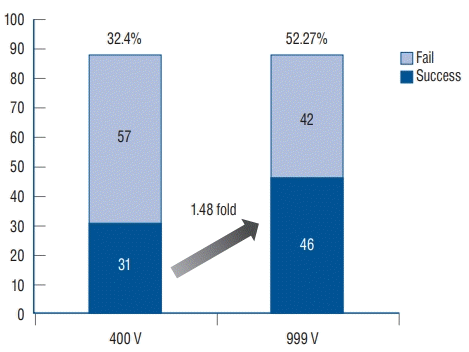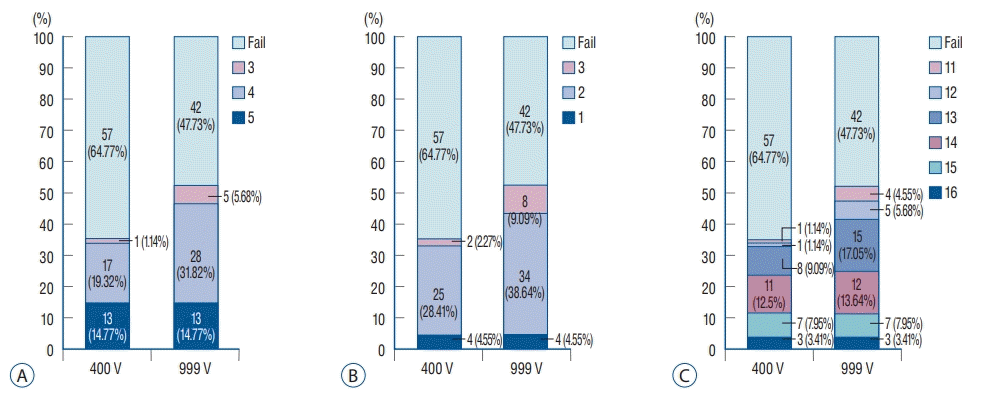1. Appel S, Biron T, Goldstein K, Ashkenazi E. Effect of intra- and extraoperative factors on the efficacy of intraoperative neuromonitoring during cervical spine surgery. World Neurosurg. 123:e646–e651. 2019.

2. Avadhani A, Rajasekaran S, Shetty AP. Comparison of prognostic value of different MRI classifications of signal intensity change in cervical spondylotic myelopathy. Spine J. 10:475–485. 2010.

3. Ayoub C, Zreik T, Sawaya R, Domloj N, Sabbagh A, Skaf G. Significance and cost-effectiveness of somatosensory evoked potential monitoring in cervical spine surgery. Neurol India. 58:424–428. 2010.

4. Benuska J, Plisova M, Zabka M, Horvath J, Tisovsky P, Novorolsky K. The influence of anesthesia on intraoperative neurophysiological monitoring during spinal surgeries. Bratisl Lek Listy. 120:794–801. 2019.

5. Bose B, Sestokas AK, Schwartz DM. Neurophysiological monitoring of spinal cord function during instrumented anterior cervical fusion. Spine J. 4:202–207. 2004.

6. Calancie B, Harris W, Brindle GF, Green BA, Landy HJ. Threshold-level repetitive transcranial electrical stimulation for intraoperative monitoring of central motor conduction. J Neurosurg. 95(2 Suppl):161–168. 2001.

7. Charalampidis A, Jiang F, Wilson JR, Badhiwala JH, Brodke DS, Fehlings MG. The use of intraoperative neurophysiological monitoring in spine surgery. Global Spine J. 10(1_suppl):104S–114S. 2020.

8. Chen X, Sterio D, Ming X, Para DD, Butusova M, Tong T, et al. Success rate of motor evoked potentials for intraoperative neurophysiologic monitoring: effects of age, lesion location, and preoperative neurologic deficits. J Clin Neurophysiol. 24:281–285. 2007.

9. Cho YE, Shin JJ, Kim KS, Chin DK, Kuh SU, Lee JH, et al. The relevance of intramedullary high signal intensity and gadolinium (Gd-DTPA) enhancement to the clinical outcome in cervical compressive myelopathy. Eur Spine J. 20:2267–2274. 2011.

10. Choi JH, Shin JJ, Kim TH, Shin HS, Hwang YS, Park SK. Does intramedullary signal intensity on MRI affect the surgical outcomes of patients with ossification of posterior longitudinal ligament? J Korean Neurosurg Soc. 56:121–129. 2014.

11. Clark AJ, Safaee M, Chou D, Weinstein PR, Molinaro AM, Clark JP 3rd, et al. Comparative sensitivity of intraoperative motor evoked potential monitoring in predicting postoperative neurologic deficits: nondegenerative versus degenerative myelopathy. Global Spine J. 6:452–458. 2016.

12. Cole T, Veeravagu A, Zhang M, Li A, Ratliff JK. Intraoperative neuromonitoring in single-level spinal procedures: a retrospective propensity score-matched analysis in a national longitudinal database. Spine (Phila Pa 1976). 39:1950–1959. 2014.
13. Eggspuehler A, Sutter MA, Grob D, Jeszenszky D, Porchet F, Dvorak J. Multimodal intraoperative monitoring (MIOM) during cervical spine surgical procedures in 246 patients. Eur Spine J. 16(Suppl 2):209–215. 2007.

14. Fouyas IP, Statham PF, Sandercock PA. Cochrane review on the role of surgery in cervical spondylotic radiculomyelopathy. Spine (Phila Pa 1976). 27:736–747. 2002.

15. Geng T, Zhu X, Xu C. Changes of T2WI high signal of spinal magnetic resonance imaging correlated with the 1-year postoperative improvement rate in patients with cervical spondylotic myelopathy. Int J Clin Exp Med. 12:13472–13479. 2019.
16. Gerling MC, Radcliff K, Isaacs R, Bianco K, Jalai CM, Worley NJ, et al. Two-year results of the prospective spine treatment outcomes study: an analysis of complication rates, predictors of their development, and effect on patient derived outcomes at 2 years for surgical management of cervical spondylotic myelopathy. World Neurosurg. 106:247–253. 2017.

17. Halawa I, Reichert K, Sommer M, Paulus W. Increasing pulse widths and intensity increase the efficacy of high frequency rTMS in inducing excitatory aftereffects. bioRxiv. 2019; [Epub ahead of print].
18. Hilibrand AS, Schwartz DM, Sethuraman V, Vaccaro AR, Albert TJ. Comparison of transcranial electric motor and somatosensory evoked potential monitoring during cervical spine surgery. J Bone Joint Surg Am. 86:1248–1253. 2004.

19. Hirabayashi K, Miyakawa J, Satomi K, Maruyama T, Wakano K. Operative results and postoperative progression of ossification among patients with ossification of cervical posterior longitudinal ligament. Spine (Phila Pa 1976). 6:354–364. 1981.

20. Ito Z, Matsuyama Y, Shinomiya K, Ando M, Kawabata S, Kanchiku T, et al. Usefulness of multi-channels in intraoperative spinal cord monitoring: multi-center study by the Monitoring Committee of the Japanese Society for Spine Surgery and Related Research. Eur Spine J. 22:1891–1896. 2013.

21. Journée HL, Polak HE, de Kleuver M, Langeloo DD, Postma AA. Improved neuromonitoring during spinal surgery using double-train transcranial electrical stimulation. Med Biol Eng Comput. 42:110–113. 2004.

22. Khan MH, Smith PN, Balzer JR, Crammond D, Welch WC, Gerszten P, et al. Intraoperative somatosensory evoked potential monitoring during cervical spine corpectomy surgery: experience with 508 cases. Spine (Phila Pa 1976). 31:E105–E113. 2006.
23. Kim DG, Jo SR, Park YS, Hyun SJ, Kim KJ, Jahng TA, et al. Multi-channel motor evoked potential monitoring during anterior cervical discectomy and fusion. Clin Neurophysiol Pract. 2:48–53. 2017.

24. Lall RR, Lall RR, Hauptman JS, Munoz C, Cybulski GR, Koski T, et al. Intraoperative neurophysiological monitoring in spine surgery: indications, efficacy, and role of the preoperative checklist. Neurosurg Focus. 33:E10. 2012.

25. Lee JM, Kim DH, Kim HS, Choi BK, Han IH. The applicability of intraoperative neuromonitoring in patients with preoperative motor weakness during spine surgery. Korean J Spine. 13:9–12. 2016.

26. Lee JY, Hilibrand AS, Lim MR, Zavatsky J, Zeiller S, Schwartz DM, et al. Characterization of neurophysiologic alerts during anterior cervical spine surgery. Spine (Phila Pa 1976). 31:1916–1922. 2006.

27. Ney JP, van der Goes DN, Watanabe JH. Cost-effectiveness of intraoperative neurophysiological monitoring for spinal surgeries: beginning steps. Clin Neurophysiol. 123:1705–1707. 2012.

28. Nuwer MR, Emerson RG, Galloway G, Legatt AD, Lopez J, Minahan R, et al. Evidence-based guideline update: intraoperative spinal monitoring with somatosensory and transcranial electrical motor evoked potentials: report of the Therapeutics and Technology Assessment Subcommittee of the American Academy of Neurology and the American Clinical Neurophysiology Society. Neurology. 78:585–589. 2012.

29. Park MK, Lee SJ, Kim SB, Lee KW, Lee HJ, Han EY, et al. The effect of positive changes during intraoperative monitoring of the functional improvement in patients with cervical compressive myelopathy. Clin Interv Aging. 13:1211–1218. 2018.

30. Rajshekhar V, Velayutham P, Joseph M, Babu KS. Factors predicting the feasibility of monitoring lower-limb muscle motor evoked potentials in patients undergoing excision of spinal cord tumors. J Neurosurg Spine. 14:748–753. 2011.

31. Sala F, Palandri G, Basso E, Lanteri P, Deletis V, Faccioli F, et al. Motor evoked potential monitoring improves outcome after surgery for intramedullary spinal cord tumors: a historical control study. Neurosurgery. 58:1129–1143. discussion 1129-1143. 2006.

32. Smith PN, Balzer JR, Khan MH, Davis RA, Crammond D, Welch WC, et al. Intraoperative somatosensory evoked potential monitoring during anterior cervical discectomy and fusion in nonmyelopathic patients--a review of 1,039 cases. Spine J. 7:83–87. 2007.

33. Taunt CJ Jr, Sidhu KS, Andrew SA. Somatosensory evoked potential monitoring during anterior cervical discectomy and fusion. Spine (Phila Pa 1976). 30:1970–1972. 2005.

34. Traynelis VC, Abode-Iyamah KO, Leick KM, Bender SM, Greenlee JD. Cervical decompression and reconstruction without intraoperative neurophysiological monitoring. J Neurosurg Spine. 16:107–113. 2012.

35. Uchida K, Nakajima H, Sato R, Kokubo Y, Yayama T, Kobayashi S, et al. Multivariate analysis of the neurological outcome of surgery for cervical compressive myelopathy. J Orthop Sci. 10:564–573. 2005.

36. Uchida K, Nakajima H, Takeura N, Yayama T, Guerrero AR, Yoshida A, et al. Prognostic value of changes in spinal cord signal intensity on magnetic resonance imaging in patients with cervical compressive myelopathy. Spine J. 14:1601–1610. 2014.

37. Wang S, Tian Y, Wang C, Lu X, Zhuang Q, Peng H, et al. Prognostic value of intraoperative MEP signal improvement during surgical treatment of cervical compressive myelopathy. Eur Spine J. 25:1875–1880. 2016.

38. Wei L, Wei Y, Tian Y, Cao P, Yuan W. Does three-grade classification of T2-weighted increased signal intensity reflect the severity of myelopathy and surgical outcomes in patients with cervical compressive myelopathy? A systematic review and meta-analysis. Neurosurg Rev. 43:967–976. 2020.

39. Xu R, Ritzl EK, Sait M, Sciubba DM, Wolinsky JP, Witham TF, et al. A role for motor and somatosensory evoked potentials during anterior cervical discectomy and fusion for patients without myelopathy: analysis of 57 consecutive cases. Surg Neurol Int. 2:133. 2011.

40. Zileli M, Borkar SA, Sinha S, Reinas R, Alves ÓL, Kim SH, et al. Cervical spondylotic myelopathy: natural course and the value of diagnostic techniques -WFNS Spine Committee Recommendations. Neurospine. 16:386–402. 2019.






 PDF
PDF Citation
Citation Print
Print






 XML Download
XML Download